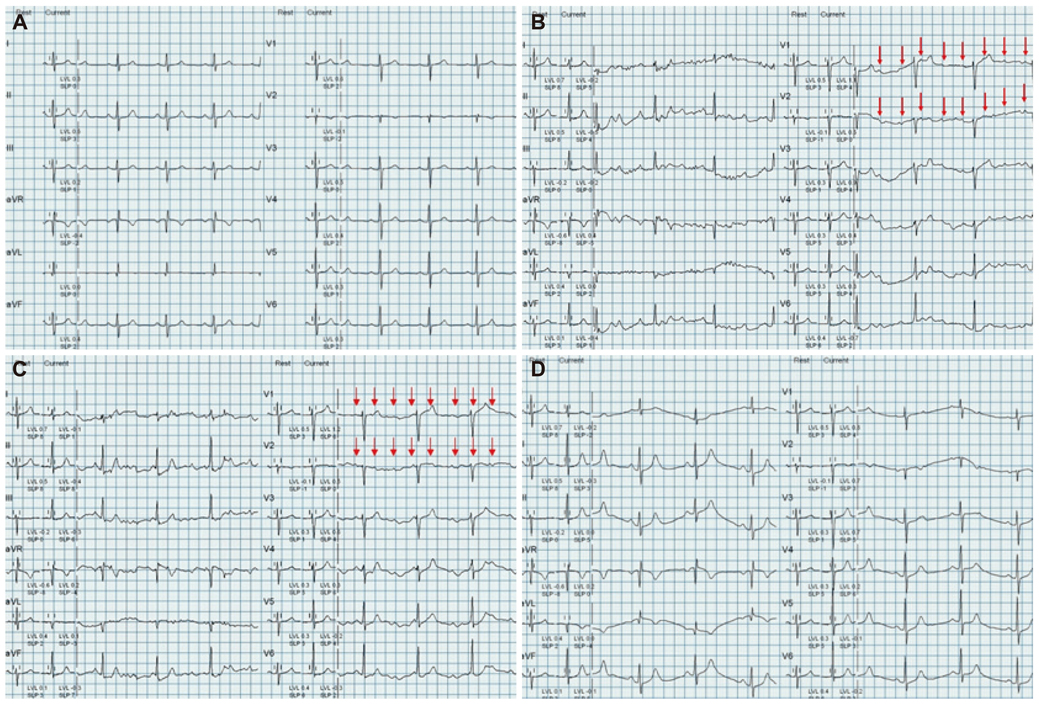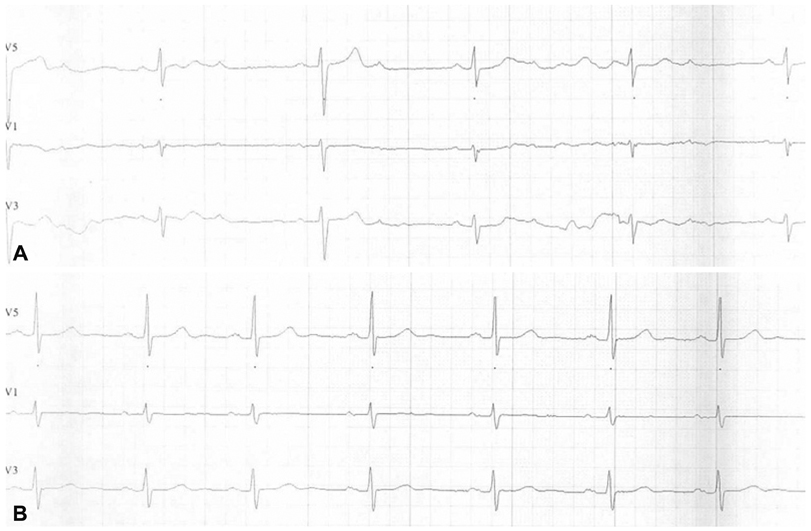Korean Circ J.
2012 Oct;42(10):698-701. 10.4070/kcj.2012.42.10.698.
Exercise-Induced Intranodal Atrioventricular Block
- Affiliations
-
- 1Division of Cardiology, Department of Internal Medicine, Pohang St. Mary's Hospital, Pohang, Korea.
- 2Division of Cardiology, Department of Internal Medicine, The Catholic University of Korea School of Medicine, Uijeongbu St. Mary's Hospital, Uijeongbu, Korea. medsws@catholic.ac.kr
- KMID: 1826467
- DOI: http://doi.org/10.4070/kcj.2012.42.10.698
Abstract
- Exercise-induced atrioventricular (AV) block in patients with normal AV conduction at rest is rare. Herein, we describe the case of a 67-year-old woman with normal 1 : 1 AV conduction at rest, who developed complete AV block during a treadmill test. Our patient complained of effort-related dizziness and dyspnea, which had been ongoing for 3 months. The patient's physical examination was normal. The resting electrocardiogram showed left anterior fascicular block with a PR interval of 0.19 seconds. The echocardiogram was normal except for mild aortic valve regurgitation. During the treadmill test, the patient developed complete AV block at a sinus rate of 90 beats/min, which was followed by 2 : 1 AV block associated with dyspnea and dizziness. The patient's coronary angiogram was normal, and the ergonovine provocation test was negative. Electrophysiological studies demonstrated rate-dependent intranodal AV block. The patient received implantation of a permanent dual chamber (DDD) pacemaker and had no further symptoms during the follow-up period.
MeSH Terms
Figure
Reference
-
1. Ozder AB, Kůçükoğlu S, Doğar H, Karcier SM, Demiroğlu C. Exercise-induced AV block. Am Heart J. 1989. 117:1407–1409.2. Egred M, Jafary F, Rodrigues E. Exercise induced atrio-ventricular (AV) block: important but uncommon phenomenon. Int J Cardiol. 2004. 97:559–560.3. Sumiyoshi M, Nakata Y, Yasuda M, et al. Clinical and electrophysiologic features of exercise-induced atrioventricular block. Am Heart J. 1996. 132:1277–1281.4. Hemann BA, Jezior MR, Atwood JE. Exercise-induced atrioventricular block: a report of 2 cases and review of the literature. J Cardiopulm Rehabil. 2006. 26:314–318.5. Choi JY, Kim HY, Rho TH, Kim JH. A case of paroxysmal atrioventricular block complicating Takayasu's Arteritis. Korean Circ J. 1994. 24:717–721.6. Kasaoka Y, Ajiki K, Hayami N, Murakawa Y. His-bundle parasystole masquerading as exercise-induced 2:1 atrioventricular block. J Cardiovasc Electrophysiol. 2001. 12:965–967.7. Pappas LK, Efremidis M, Sideris A, Letsas KP, Kounas SP, Kardaras F. Exercise-induced second-degree atrioventricular block. Int J Cardiol. 2006. 111:461–463.8. Martí-Almor J, Cladellas M, Bruguera J. Atrioventricular block induced by exercise is not always infrahisian. Rev Esp Cardiol. 2005. 58:1247–1248.
- Full Text Links
- Actions
-
Cited
- CITED
-
- Close
- Share
- Similar articles
-
- Atrioventricular nodal re‑entrant tachycardia with a 2:1 atrioventricular block in a young man: What is the mechanism?
- Mobitz type I atrioventricular block induced by atrial pacing in a patient undergoing off-pump coronary artery bypass surgery: A case report
- Recurrent Syncope Episodes and Exercise Intolerance in Hypertrophic Cardiomyopathy Combined with Atrioventricular Conduction Disturbance
- Development of a Complete Atrioventricular Block Associated with Intake of Evening Primrose Oil
- A case of complete atrioventricular block persisting for 5 days in a patient with variant angina




